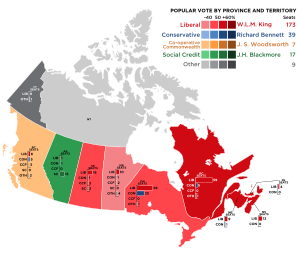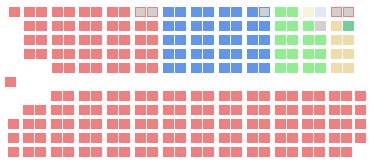1935 Canadian federal election
| |||||||||||||||||||||||||||||||||||||||||||||||||||||||||||||||||||||||||||||||||||||||||
245 seats in the House of Commons 123 seats needed for a majority | |||||||||||||||||||||||||||||||||||||||||||||||||||||||||||||||||||||||||||||||||||||||||
|---|---|---|---|---|---|---|---|---|---|---|---|---|---|---|---|---|---|---|---|---|---|---|---|---|---|---|---|---|---|---|---|---|---|---|---|---|---|---|---|---|---|---|---|---|---|---|---|---|---|---|---|---|---|---|---|---|---|---|---|---|---|---|---|---|---|---|---|---|---|---|---|---|---|---|---|---|---|---|---|---|---|---|---|---|---|---|---|---|---|
| Turnout | 74.2%[1] ( | ||||||||||||||||||||||||||||||||||||||||||||||||||||||||||||||||||||||||||||||||||||||||
| |||||||||||||||||||||||||||||||||||||||||||||||||||||||||||||||||||||||||||||||||||||||||
 | |||||||||||||||||||||||||||||||||||||||||||||||||||||||||||||||||||||||||||||||||||||||||
 The Canadian parliament after the 1935 election | |||||||||||||||||||||||||||||||||||||||||||||||||||||||||||||||||||||||||||||||||||||||||
| |||||||||||||||||||||||||||||||||||||||||||||||||||||||||||||||||||||||||||||||||||||||||
The 1935 Canadian federal election was held on October 14, 1935, to elect members of the House of Commons of Canada of the 18th Parliament of Canada. The Liberal Party of William Lyon Mackenzie King won a majority government, defeating Prime Minister R. B. Bennett's Conservatives.[2]
The central issue was the economy, which was still in the depths of the Great Depression. In office since the 1930 election, Bennett had sought to stimulate the economy during his first few years through a policy of high tariffs and trade within the British Empire. In the last months of his time in office, he reversed his position, copying the popular New Deal of Franklin Roosevelt in the United States. Upset about high unemployment and inaction by the federal government, voters were unwilling to allow the Conservatives to continue to govern, despite their change of policy.
The Conservatives were also suffering severe internal divisions. During his first years in office, Bennett had alienated those in his party who supported intervention in the economy. His last minute conversion to interventionism alienated the rest of the party. Former cabinet minister H.H. Stevens left to form the Reconstruction Party. Senior minister Sir Joseph Flavelle announced he would be supporting the Liberals.
Voters opted for Mackenzie King's promise of mild reforms to restore economic health. The Liberals crushed the Tories, winning 173 seats to the Conservatives' 39, the worst ever performance by the Tories until their collapse in 1993. The Liberal Party would continue to hold power until 1957.
The 1935 election was also important in it saw the final demise of the Progressive Party and the United Farmers of Alberta. The Progressive Party, having been in gradual decline over the previous decade, did not run any candidates under its own banner. The federal party, always highly decentralized, ceased to exist sometime circa 1940. However, Liberal-Progressive Premier of Manitoba John Bracken brought the name back into formal use when he moved to federal politics in 1942; his first act as leader of the Conservatives was to rechristen them the Progressive Conservative Party.
The United Farmers of Alberta, whose credibility was ruined by a sex scandal involving former leader John E. Brownlee, lost all their seats in the provincial election earlier that year, and subsequently withdrew from electoral politics, likewise fielding no candidates in this federal election.
Two new movements rose out of the west, however. The new Co-operative Commonwealth Federation, a social democratic party, first competed in this election and won seven seats, promising social reform. The Social Credit Party of Canada was even more successful, capturing seventeen seats on its platform of monetary reform despite winning less of the popular vote than the former. Fifteen of these seats were in Alberta, where the party dominated after having swept to power in a landslide less than two months before the federal vote. John Horne Blackmore was chosen to lead the Social Credit caucus after the election. The de facto leader of the national movement was Alberta Premier William Aberhart, who did not stand in the federal election himself.
National results
[edit]
| Party | Party leader | # of candidates |
Seats | Popular vote | |||||
|---|---|---|---|---|---|---|---|---|---|
| 1930 | Elected | % Change | # | % | pp Change | ||||
| Liberal | W. L. Mackenzie King | 245 | 90 | 173 | +92.2% | 1,967,839 | 44.68% | +0.65 | |
| Conservative | R. B. Bennett | 228 | 134 | 39 | -70.9% | 1,290,671 | 29.30% | -18.48 | |
| Social Credit | 46 | * | 17 | * | 180,679 | 4.10% | * | ||
| Co-operative Commonwealth | J. S. Woodsworth | 121 | * | 7 | * | 410,125 | 9.31% | * | |
| Liberal–Progressive | 5 | 3 | 4 | +33.3% | 29,569 | 0.67% | -0.48 | ||
| Reconstruction | H.H. Stevens | 172 | * | 1 | * | 384,462 | 8.73% | * | |
| Independent Liberal | 24 | - | 1 | 54,239 | 1.23% | +0.86 | |||
| Independent | 14 | 2 | 1 | -50.0% | 17,897 | 0.40% | -0.15 | ||
| United Farmers of Ontario-Labour | 1 | - | 1 | 7,210 | 0.16% | +0.16 | |||
| Independent Conservative | 4 | - | 1 | 1,078 | 0.02% | -0.24 | |||
| Communist | Tim Buck | 12 | - | - | - | 20,140 | 0.46% | +0.34 | |
| Labour | 5 | 2 | - | -100% | 14,423 | 0.33% | -0.35 | ||
| Progressive-Conservative | 2 | 1 | - | -100% | 12,220 | 0.28% | -0.13 | ||
| Verdun | 1 | * | - | * | 4,214 | 0.10% | * | ||
| Anti-Communist | 1 | * | - | * | 3,961 | 0.09% | * | ||
| Unknown | 2 | - | - | - | 2,717 | 0.08% | -0.11 | ||
| Independent Reconstructionist | 1 | * | 0 | * | 865 | 0.02% | * | ||
| Technocrat | 1 | * | 0 | * | 733 | 0.02% | * | ||
| Liberal-Labour | 3 | - | - | - | 708 | 0.02% | -0.17 | ||
| Socialist Party of Canada (WSM) | 1 | * | - | * | 251 | 0.01% | * | ||
| Independent Labour | 1 | - | - | - | 221 | 0.01% | -0.41 | ||
| Veteran | 1 | * | - | * | 79 | x | * | ||
| Total | 891 | 245 | 245 | - | 4,404,301 | 100% | |||
| Sources: http://www.elections.ca -- History of Federal Ridings since 1867 | |||||||||
Notes:
* The party did not nominate candidates in the previous election.
x - less than 0.005% of the popular vote
Vote and seat summaries
[edit]Results by province
[edit]| Party name | BC | AB | SK | MB | ON | QC | NB | NS | PE | YK | Total | ||
|---|---|---|---|---|---|---|---|---|---|---|---|---|---|
| Liberal | Seats won by party: | 6 | 1 | 16 | 10 | 56 | 59 | 9 | 12 | 4 | - | 173 | |
| Popular Vote (%): | 31.8 | 21.6 | 40.8 | 31.7 | 42.2 | 56.0 | 57.2 | 52.7 | 58.3 | 44.4 | 44.7 | ||
| Conservative | Seats: | 5 | 1 | 1 | 1 | 25 | 5 | 1 | - | - | 39 | ||
| Vote: | 24.9 | 17.6 | 18.0 | 27.9 | 35.8 | 27.5 | 31.9 | 34.5 | 38.4 | 29.8 | |||
| Co-operative Commonwealth | Seats: | 3 | - | 2 | 2 | - | - | 7 | |||||
| Vote: | 32.7 | 12.0 | 21.3 | 19.4 | 8.0 | 0.6 | 8.8 | ||||||
| Social Credit | Seats: | - | 15 | 2 | - | 17 | |||||||
| Vote: | 0.6 | 46.6 | 17.8 | 2.0 | 4.1 | ||||||||
| Liberal-Progressive | Seats: | 4 | 4 | ||||||||||
| Vote: | 10.5 | 0.7 | |||||||||||
| Reconstruction | Seats: | 1 | - | - | - | - | - | - | - | - | 1 | ||
| Vote: | 7.3 | 0.7 | 1.3 | 5.9 | 11.4 | 9.3 | 9.7 | 12.7 | 3.4 | 8.7 | |||
| Independent Liberal | Seats: | - | - | 1 | - | - | 1 | ||||||
| Vote: | 0.2 | 0.6 | 3.8 | 0.4 | 3 | 1.2 | |||||||
| Independent | Seats: | 1 | - | - | - | - | 1 | ||||||
| Vote: | 1.8 | 0.1 | 0.2 | 0.7 | 0.8 | 0.4 | |||||||
| UFO-Labour | Seats: | 1 | 1 | ||||||||||
| Vote: | 0.5 | 0.2 | |||||||||||
| Independent Conservative | Seats: | - | 1 | 1 | |||||||||
| Vote: | xx | 55.6 | xx | ||||||||||
| Total Seats | 16 | 17 | 21 | 17 | 82 | 65 | 10 | 12 | 4 | 1 | 245 | ||
| Parties that won no seats: | |||||||||||||
| Communist | Vote: | 0.5 | 1.1 | 0.8 | 0.7 | 0.5 | 0.3 | 0.5 | |||||
| Farmer-Labour | Vote: | 0.3 | 0.5 | 0.5 | 0.3 | ||||||||
| Progressive-Conservative | Vote: | 0.5 | 0.7 | 0.1 | |||||||||
| Verdun | Vote: | 0.4 | 0.1 | ||||||||||
| Anti-Communist | Vote: | 0.2 | 0.1 | ||||||||||
| Unknown | Vote: | 0.x | 0.x | 0.1 | |||||||||
| Independent Reconstruction | Vote: | 0.1 | xx | ||||||||||
| Technocrat | Vote: | 0.3 | xx | ||||||||||
| Liberal-Labour | Vote: | 0.1 | xx | ||||||||||
| Socialist | Vote: | 0.1 | xx | ||||||||||
| Independent Labour | Vote: | 0.x | xx | ||||||||||
| Veteran | Vote: | 0.x | xx | ||||||||||
- xx - less than 0.05% of the popular vote
See also
[edit]- List of Canadian federal general elections
- List of political parties in Canada
- 18th Canadian Parliament
Further reading
[edit]- The Editors, ed. (1939). The Canadian Annual Review of Public Affairs, 1935 and 1936. Toronto: The Annual Review Company.
{{cite book}}:|editor=has generic name (help) - H. Blair Neatby, William Lyon Mackenzie King: 1932-1939 (1976)
- J. R. H. Wilbur (1968). The Bennett new deal: fraud or portent?. Copp Clark.
- MacKenzie, David (2023). King and Chaos: The 1935 Canadian General Election. UBC Press.
Notes
[edit]- ^ Aberhart was Premier of Alberta, and represented the provincial seat of Okotoks-High River, but was not a candidate in the federal election. John Horne Blackmore acted as Social Credit's parliamentary leader afterwards.
References
[edit]- ^ "Voter Turnout at Federal Elections and Referendums". Elections Canada. Retrieved March 10, 2019.
- ^ Reid, Escott (1936). "The Canadian Election of 1935—and After". American Political Science Review. 30 (1): 111–121. doi:10.2307/1948012. ISSN 0003-0554. JSTOR 1948012. S2CID 147100835.





